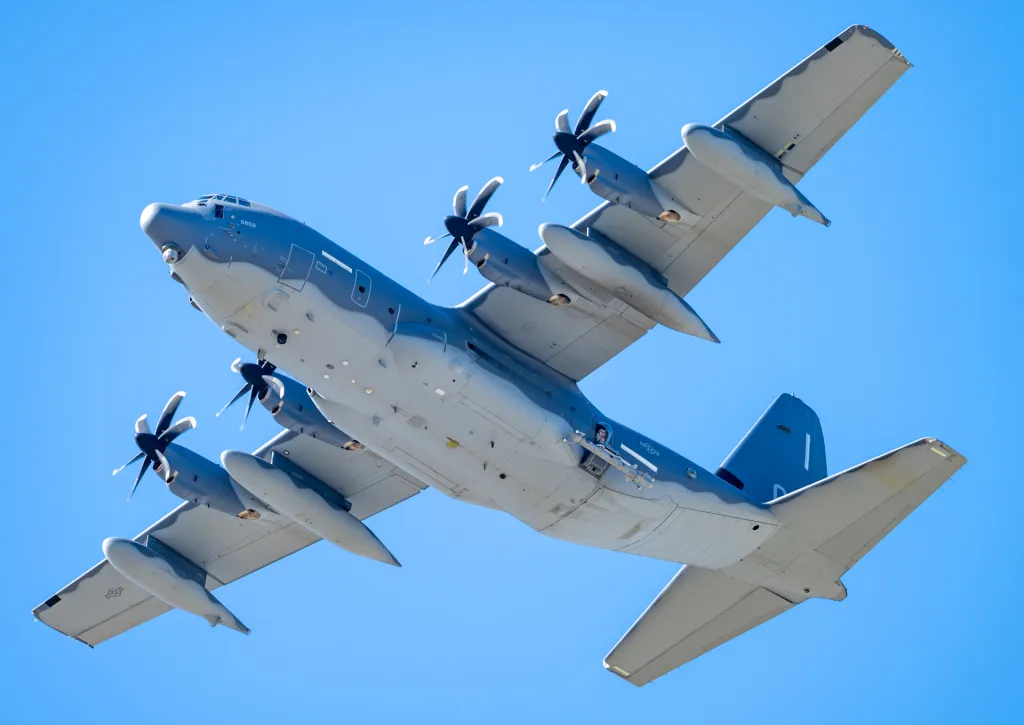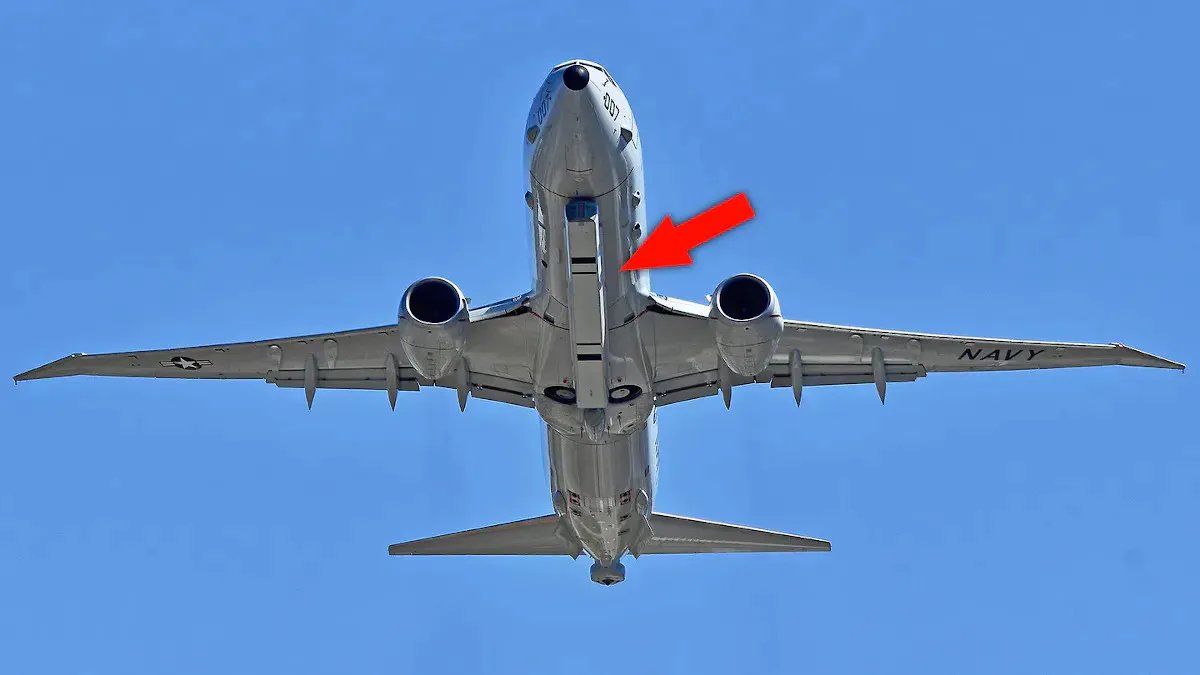Angry Kitten Electronic Warfare Pod Spotted Flying On HC-130J Combat Rescue Plane
New pictures offer the best look to date of an Air Force HC-130J Combat King II combat search and rescue aircraft (CSAR) carrying an Angry Kitten electronic warfare pod. Originally developed to simulate enemy electronic warfare attacks during training and testing, Angry Kitten has been evolving into a system that could help protect friendly aircraft from those threats during real combat missions. Pairing HC-130Js and the pods is now being eyed as part of the answer to an increasingly vexing question of how to provide adequate CSAR coverage for future operations in and around heavily contested airspace.
Fred Taleghani of FreddyB Aviation Photography caught the HC-130J Combat King II with the Angry Kitten pod flying around Point Mugu, California, back on September 11. The aircraft in question belongs to the California Air National Guard’s 129th Rescue Wing, which is based at Moffett Federal Airfield, situated some 275 miles to the northwest. HC-130Js can support CSAR missions in various ways, including by helping to deploy pararescuemen, refueling HH-60W Jolly Green IIs and other helicopters, as well as Osprey tilt-rotors, in mid-air, and acting as airborne command and control nodes.

The Angry Kitten pod is seen mounted via a Special Airborne Mission Installation and Response (SABIR) system installed in place of the HC-130J’s left rear paratrooper door. SABIR includes a pylon on an arm that can be extended below the aircraft’s fuselage while in flight, giving whatever is loaded onto it a more unobstructed field of view. The replacement paratrooper door also features an enlarged observer’s window. It can be fitted with a chute for launching sonobouys, smoke markers, and other similar tubular payloads, though it is not clear if that capability is installed on this Combat King II. The port for the chute is visible, but it may be blanked off. The U.S. military and foreign armed forces use SABIR as a relatively simple way to integrate other sensors and systems onto different C-130 variants, as you can read more about here.



The Angry Kitten-toting HC-130J is understood to have been in the Point Mugu area at the time to take part in the U.S. Navy-led Gray Flag 2025 test and evaluation exercise, which ran between September 5 and 19. It was staged out of Naval Base Ventura County and involved sorties over the expansive Point Mugu Sea Range. Gray Flags are regularly used to showcase new and improved munitions and other advanced capabilities, such as electronic warfare systems, including ones that are still in development. Units from across the U.S. military, as well as key American allies, routinely take part. Combat King IIs have participated in these exercises in the past.

As noted, Angry Kitten is not new. Georgia Tech Research Institute (GTRI) began development of the podded system in 2013, and it first started flying under the wings of F-16 Viper fighters in 2017. Angry Kitten is an outgrowth of the AN/ALQ-167 electronic warfare pod, variants of which have been in use for decades, primarily to mimic hostile electronic warfare threats for training and testing purposes. There are also documented examples of AN/ALQ-167s being used on aircraft during actual combat missions, at least on an ad hoc basis.


Unlike the older AN/ALQ-167s, Angry Kitten is designed to be more readily modifiable and updatable to more rapidly adapt in parallel with the threat ecosystem. This is enabled in part by advanced Digital Radio Frequency Memory (DRFM) technology, which allows radio frequency (RF) signals to be detected and ‘captured,’ as well as manipulated and retransmitted. Electronic warfare systems that use DRFM can project signals from hostile radars (and radar seekers on missiles) back at them to create false or otherwise confusing tracks. Data collected via DRFM can also be used to help improve and refine the system’s capabilities, as well as for other intelligence exploitation purposes.
In general, electronic warfare systems need to be able to accurately detect, categorize, and respond to waveforms based on information contained in their built-in threat libraries to work most effectively. This, in turn, requires specialists to routinely reprogram systems to keep them as up to date as possible. Automating and otherwise shortening that process at every step of the way by developing what are known as cognitive electronic warfare capabilities has become a major area of interest for the entire U.S. military. The absolute ‘holy grail’ of that concept is an electronic warfare system capable of adapting its programming autonomously in real-time, even in the middle of a mission, as you can read more about here.
With all this in mind, and given prior operational use of the AN/ALQ-167, it’s not hard to see how interest has grown in using Angry Kitten to help shield friendly aircraft from threats during real-world missions.
“We had a jammer called ‘Angry Kitten.’ It was built to be an adversary air jamming tool,” now-retired Air Force Gen. Mark Kelly, then commander of Air Combat Command (ACC), told TWZ and other outlets back in 2022. “And all of a sudden, the blue team said, ‘you know, hey, we kind of need that, can we have that for us?’ And so I see this iterating and testing our way into this.”

To date, in addition to F-16s and HC-130s, Angry Kitten is known to have flown on Air Force A-10 Warthog ground attack jets and MQ-9 Reaper drones, as well as Navy F/A-18s fighters. As of March, the Air National Guard Air Force Reserve Command Test Center (AATC) said there were plans to at least evaluate the pod on KC-135 and KC-46 aerial refueling tankers.
It’s also interesting to note the parallels here with the U.S. Marine Corps’ Intrepid Tiger II electronic warfare system, which has been fielded in different podded forms for the AV-8B Harrier jump jet and the UH-1Y Venom armed light utility helicopter. A roll-on/roll-off version for the MV-22 Osprey tilt-rotor is in development, and there are plans to integrate the capability in some form onto the KC-130J tanker/transport. Different variants of Intrepid Tiger also offer degrees of secondary intelligence-gathering capabilities.

AATC has also explicitly highlighted the potential benefits of combining Angry Kitten with the HC-130J in the context of the CSAR mission.
“Angry Kitten pod is showing promising results in protecting larger radar cross-section (RCS) platforms that traditionally lack robust electronic warfare capabilities,” according to a release AATC put out in March. “This success is particularly significant for combat search and rescue platforms that often operate in contested environments without electronic warfare protection.”
“We had minimal hopes for what we could do for larger body aircraft, but it’s showing that we actually have good effects,” Chris Culver, an electronic warfare engineer involved in the work, had said.
For years now, TWZ has been highlighting growing concerns about the basic feasibility of traditional fixed-wing CSAR aircraft and helicopters performing their mission amid a threat ecosystem that is steadily expanding in scale and scope. Future high-end fights, such as one against China in the Pacific, will involve air operations in areas where even stealthy platforms are expected to be increasingly at risk. In 2022, the Air Force announced it was scaling back purchases of new HH-60W CSAR helicopters in light of this reality. Top service officials have talked in the past about having to approach this still critical mission set differently going forward.

“There are a lot of other assets around that, if somebody goes down at sea, for example, we could use to pick them up,” then-Secretary of the Air Force Frank Kendall said in 2023. “We’re going to do it [the CSAR mission] with existing assets, either our own or provided by other military departments.”
Many of these same general concerns apply to the Air Force’s existing non-stealthy KC-135 and KC-46 tanker fleets. Air Force officials regularly point to add-on defensive capabilities, which might include Angry Kitten, as one near-term option for increasing the survivability of its key aerial refueling assets.
Integrating Angry Kitten on larger aircraft could have other implications as another important stepping stone for new cognitive electronic warfare capabilities.
“The C-130 testing features innovative real-time updates to electronic warfare techniques,” according to the AATC release in March. “Unlike the F-16 tests, where pre-programmed mission data files were used, the C-130 testing includes development engineers aboard the aircraft who can modify jamming techniques mid-mission based on feedback from range control.”
“They are making changes [in] real-time to the techniques and pushing updates to the pod, seeing the change in real-time,” Culver, the electronic warfare engineer, had also said. “This approach allows for rapid optimization of jamming techniques against various threat systems.”

A follow-on Advanced Test and Training Capability (ATTACK) pod, also referred to unofficially as Angry Kitten Increment 2 Block 2, is also now in the works. The “next-generation system will feature a complete hardware refresh, transitioning from analog to digital receivers for improved sensitivity and frequency agility,” according to AATC.
Altogether, the HC-130J seen carrying the Angry Kitten pod around Point Mugu earlier this month is an important sign of things to come.
Contact the author: [email protected]





